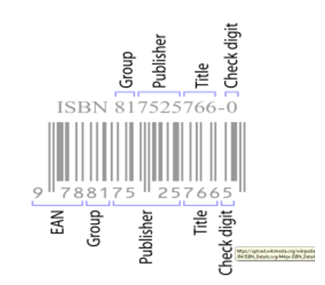FAQ ISBN & ISSN
Background of ISBN
The ISBN is a unique international identifier for monographic publications. It assigns a number which replaces the handling of long bibliographic descriptive records, thereby saving time and staff costs and reducing copying errors. ISBN is based on ISO 2108:2017. The purpose of ISO 2108:2017 is to establish the specifications for the International Standard Book Number (ISBN) as a unique international identification system for each product form or edition of a monographic publication published or produced by a specific publisher. It specifies the construction of an ISBN, the rules for its assignment and use, the metadata to be associated with the ISBN allocation, and the administration of the ISBN system.
ISO 2108:2017 is applicable to monographic publications (or their individual sections or chapters where these are made separately available) and certain types of related products that are available to the public.
The purpose of the international standard is to coordinate and standardize the international use of ISBNs to identify uniquely one publication or edition of a publication published by one specific publisher in one specific format.
The ISBN denotes a particular monographic publication uniquely and should, therefore, be associated with it from early production stages. An essential instrument in production, distribution, sales analysis, and bibliographic data storage systems in the book trade, ISBN is also of vital importance to library information management.
An International Standard Book Number is an identifier for monographic publications allocated under the aegis of the International ISBN Agency to a registrant in accordance with the specifications of International Standard ISO 2108: Information and documentation - International standard book number (ISBN).
Print-on-demand publication
Publication that is printed at the time of a customer order rather than being supplied from existing stock held by the distributor or publisher.
Publisher
The individual or corporation responsible for all stages in the creation, production, dissemination and marketing of digital or printed publications.
The publisher is normally responsible for the content and for any financial risk involved in the process.
Structure of the ISBN
The system of ISBN started in 1967 in the United Kingdom by David Whitakerand in 1968 in the US by Emery Koltay. The International Organization for Standardization (ISO) developed the 10 digit format for ISBN. Since 1 January 2007, ISBNs have contained 13 digits, a format that is compatible with European Article Number (EAN).
The13 digits comprise the following elements:
• Prefix element
• Registration group element
• Registrant element
• Publication element
• Check digit

When printed, the ISBN is always preceded by the letters “ISBN”. The ISBN is divided into five elements, three of them of variable length; the first and last elements are of fixed length. The elements must each be separated clearly by hyphens or spaces when displayed in human readable form:
ISBN 978– 93-5287-000–4
or
ISBN 978 93 5287 000 4
Note: The use of hyphens or spaces has no lexical significance and is purely to enhance readability.
The number of digits in the second, third, and fourth elements of the ISBN (registration group element, registrant element, publication element) varies. The length of the registration group element and of the registrant element is relative to the anticipated publishing output of the registration group or registrant. When these elements are short in length it indicates that the output of the registration group or the registrant (or both) is expected to be a large number of publications.
How ISBNs are issued
ISBN issuance is country-specific, in that ISBNs are issued by the ISBN registration agency that is responsible for that country or territory regardless of the publication language. The ranges of ISBNs assigned to any particular country are based on the publishing profile of the country concerned, and so the ranges will vary depending on the number of books and the number, type, and size of publishers that are active. Some ISBN registration agencies are based in national libraries or within ministries of culture and thus may receive direct funding from government to support their services. In other cases, the ISBN registration service is provided by organizations such as bibliographic data providers that are not government funded.
Benefits of the ISBN
>> Correct use of the ISBN allows different product forms and editions of a book, whether printed or digital, to be clearly differentiated, ensuring that customers receive the version that they require.
>> The ISBN facilitates compilation and updating of book-trade directories and bibliographic databases, such as catalogues of books-in-print. Information on available books can be found easily.
>> Ordering and distribution of books is mainly executed by ISBN; this is a fast and efficient method.
>> The ISBN is machine-readable in the form of a 13-digit EAN-13 bar code. This is fast and avoids mistakes.
>> The ISBN is required for the running of electronic point-of-sale systems in bookshops.
>> Many publishing and supply chain systems are based on ISBN
>> The accumulation of sales data is done by the ISBN. This enables the varying successes of different product forms and editions of publications to be monitored, as well as enabling comparisons between different subject areas and even different publishing houses.